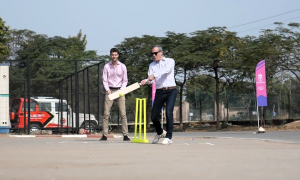Spinners role in test matches have been inevitable. Especially the greats of the game, Murali, Warne, Kumble etc have had the reputation of picking up more no. of wickets than their pace counterparts put together. They have been the lynchpin of their sides delivering whenever their services are called for and sometimes even without it.
But initially in the one-dayers, though they picked up a lot of wickets, their economy rate doesn’t speak in their favor. This given, with the shortest format of the game cutting its teeth in cricket, they were expected to be taken for runs given the shorter boundaries, limited no. of overs and mindset of the batsman.
And then this was one of the greatest ironies in world cricket! Shane Warne threw the new ball to Yusuf Pathan the part-time an off-spinner, a role which was earlier believed not to suit the new ball. To add to everyone’s fad, Pathan not only bowled economically but also picked up wickets. The tactic didn’t go without recognition, as a lot of teams started to bowl spinners in the powerplay overs. This is where the spinners’ roles were redefined and they started to earn the captain’s trust in every part of the game.
In this World Cup, the conditions weren’t believed to assist those from non-sub-continental countries. Eventually, those guesses were proved to be wrong (Probably the teams that toured here didn’t hear the gossips around.) South Africa played a game with three spinners! The team was expected to field three seamers for, fast bowling is their strength. Swann has also played a big role for England. Afridi has always been the X-factor for Pakistan picking up a lot of wickets and bowling clueless spells in the middle. Murali hasn’t been as magical as you would want him to be but has bowled a lot of decent spells, one would say.
Interestingly it was India which played a game with three seamers and a lone spinner – Harbhajan Singh (though Yuvraj was always expected to accompany him.) Here is where Dhoni got it wrong. The Proteas aren’t great players of spin and hence there were too many questions, again only after the game was over, against his decision to field three pacemen. It was indeed a mistake, big enough to cost us the whole game.
Dhoni as he himself confessed in a post-match interview, Ashwin is a mentally tough bowler who could adapt to the conditions very well. Something that adds to his features is his ability to bowl in the powerplay and the variations he has embraced over the years. May be he thought the attack will lack variety, something that cannot be attributed to bad thinking.
India’s bowling has been lamentable, especially when the opponents are chasing a big score. This lays a great emphasis on the need to give the spinner the lead role. There must be someone who could bowl in the powerplays and still pick up wickets; someone who could make the run rate of the opponents to plummet in the middle overs; someone who could back himself under thwarting pressure conditions. The spinners in the squad have the capability to justify these roles and must therefore be assigned suitable roles to play in the team.
Having adept knowledge about the conditions, better than any other team should act in favor of India which isn’t happening now. For that to happen there must be some bold decisions to make. Dhoni must consider changing the eleven they have fielded in the last few games and not go by whimsical decision making.
Tags: Cricket, ICC Cricket World Cup 2011, Ravichandran Ashwin, Spinners, World Cup










